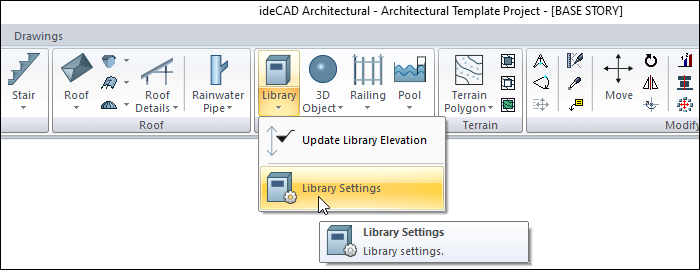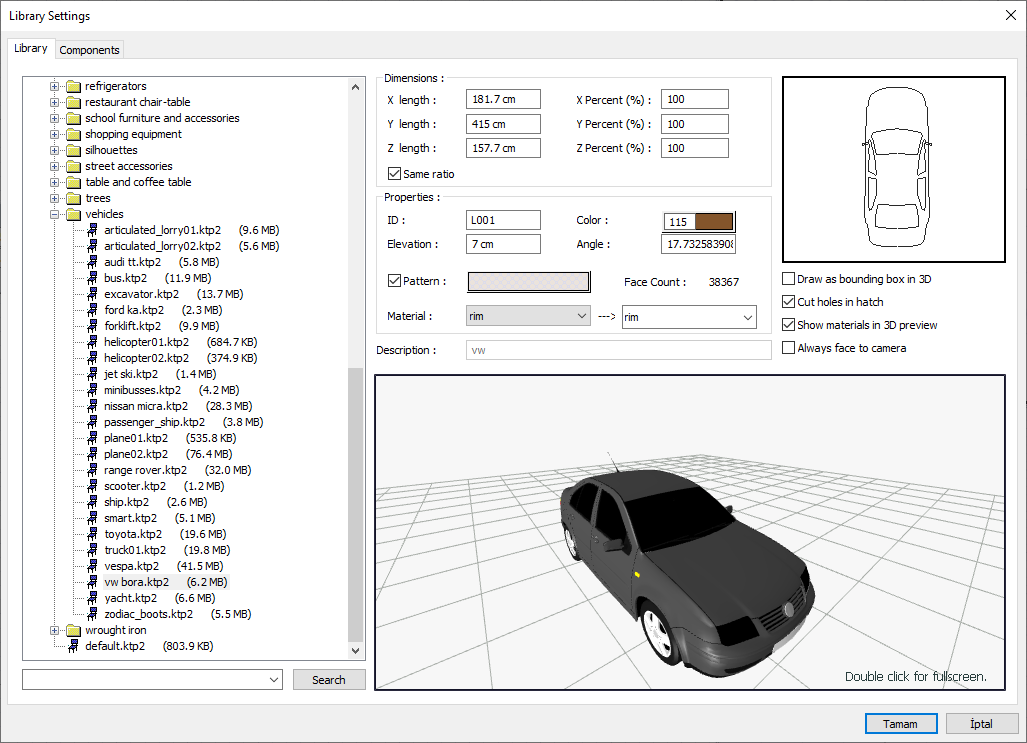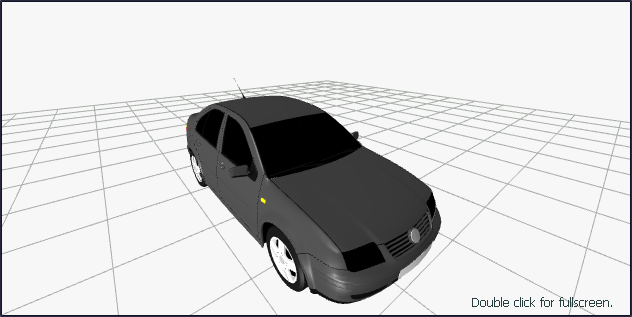Library Settings
With the Library Settings command, settings such as library type selection, dimensions, elevation and material selection are accessed.
Location of Library Settings Dialog
After running the library command, the library that appears on the screen is in the auxiliary toolbar.

You can also access it under the ribbon menu Home tab, Entities title in the architectural program.

Library Tab

Specifications | |
|---|---|
Object list  Furnishing elements are gathered in the library settings dialog and organized under folders according to their types. You can choose any furnishing element here. | |
X length/X percent  The X dimension (width) of the selected element. Replaceable. The change made is given as a percentage based on design measures. If desired, object dimensions can be changed by entering the percentage value. | |
Y length/Y percent  The Y dimension (length) of the selected element. Replaceable. The change made is given as a percentage based on design measures. If desired, object dimensions can be changed by entering the percentage value. | |
Z length/Z percent  The Z dimension (height) of the selected element. Replaceable. The change made is given as a percentage based on design measures. If desired, object dimensions can be changed by entering the percentage value. | |
Same ratio  It is used for automatic changing of dimensions in any direction of the library, at the same rate in the other direction. | |
ID  Includes the name of the selected library. Replaceable. | |
Color  The drawing color of the library object in the plan. When the color box is clicked, the appropriate color is selected from the window that opens. | |
Elevation  The vertical distance (level) of the lower face of the wall (wall base) measured from the floor base is entered. The vertical distance (elevation) of the selected element measured from the floor is entered. | |
Angle  The angle (degrees) of the selected element in the drawing area. As the furnishing is drawn, its angle changes with the movement of the mouse. If wanted, the object angle can be changed here. | |
Pattern  It is the pattern type valid for the library. When checked, the library object appears in the plans with hatching. When the search box is clicked, the appropriate pattern type is selected from the window that opens. | |
Face count  Shows the count of surfaces the selected object has. It cannot be intervened. | |
Material  Clicking the down arrow buttons to the right of the boxes opens the list of available materials for the relevant library. Any of these materials can be clicked with the mouse and selected. | |
Description  | Includes the description of the selected object. It cannot be intervened. |
Plan view  The plan drawing of the selected object is given. | |
Draw as a bounding box in 3D  By marking, libraries are shown in 3 dimensions only as a frame, not detailed. You can check this option to increase the performance of working on the project. | |
Cut holes in hatch  When the library is placed on hatching, this option is checked if it is wanted to clean (trim) the hatch under the library. | |
Show materials in 3D preview  By marking, libraries selected in the preview preview are displayed on the assigned textures. | |
Always face to camera  Silhouettes and library objects are automatically turned perpendicular to the camera without having to be placed perpendicular to the camera. | |
Perspective preview  Three-dimensional view of the selected object is included. If the mouse is moved while holding down the left mouse button, the object will be rotated. If the mouse is moved by clicking the right mouse button, the object can be zoomed in and out. In this way, it is possible to examine the object in three dimensions. | |
Components Tab

Add building components: Assigns the building materials defined for the detailed building components metering to the wall object.
Click the Add Building Component button.
The Component Selection dialog will open.
In this dialog, click the folder related to the material from the list on the left. Choose the material you want to use.
Set the parameters on the right.
Click the OK button. The "Component Selection" dialog will be closed. A summary line of the material will appear in the Building Components tab. More than one material assignment can be made to an object.

In the usage section
No modification: The amount of material to be assigned for the object in question is marked when it is desired to be used in the size that was previously specified in the material definition.
Percentage: This line is marked when it is desired to be used with the percentage of the amount previously determined in the material definition, as much as the value entered in the "Value 1" line in the same dialog. For example, if the material quantity is 70, if the line “Value 1” says 40, it means the material amount will be used up to 40 * 70%.
Override: This line is marked so that the quantity entered in the “Value 1” line in the same dialog will be used instead of the quantity previously determined in the material definition.
Multiplier: This line is marked in order to use the value found at the end of the multiplication of the value entered in the "Value 1" line in the same dialog with the amount previously determined in the material definition.
Fraction: This line is marked so that the amount determined in the material definition before will be used as the fraction value created by the values entered in the "Value 1" and "Value 2" lines in the same dialog. "Value 1" is the denominator "Value 2" is the denominator.
Proportional to: It is determined to what scale-area, circumference, length etc.-, region-side area, top, edge etc.- the material will be proportioned to. The content of the proportional list box is automatically determined according to the object and the size of the material. For example, a different list will be created if an operation is made for the column, a different list will be created for the library, a different list for the volume, and a different list for the field.
Following are the lines that appear in the proportion list according to the library object and material size.
Library | ||
Measure | Listed | Explanation |
Constant | Independent | The fixed measure used will be used exactly as the amount. |
Length | Independent | It means that the length measure found while defining the material will be used exactly as the length value. |
X lenght | It means that the length of the material will be found by multiplying the length measure found while defining the material and the X length value of the library. | |
Y lenght | It means that the length of the material will be found by multiplying the length measure found while defining the material and the Y length value of the library. | |
Z lenght | It means that the length of the material will be found by multiplying the length measure found while defining the material and the Z length value of the library. | |
Area | Independent | It means that the area measure found while defining the material will be used exactly as the field value. |
Volume | Independent | The volume measurement found when defining the material will be used exactly as the volume value. |
Count | Independent | The number count found while defining the material will be used exactly as the number value. |
Count | The count measure found while defining the material will be used exactly as the number value. | |
Next Topic
